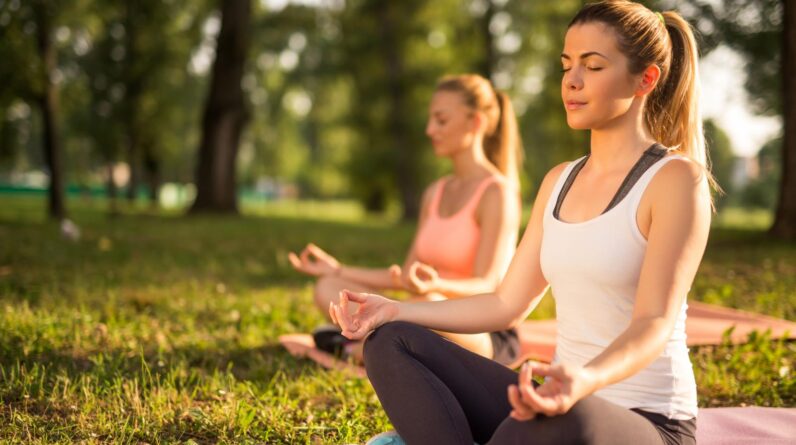
Do you enjoy running? You should include yoga in your daily routine. Yoga for runners is important as it can provide strength and stamina.
Whether you are a marathon runner or casual jogger, you must know your body’s limitations. Running is great for your health and if you enjoy running, you probably like to set new goals before you put on your sport shoes. Running faster than before or covering more distance may be some of those goals. But being a regular runner also means knowing your own limitations. You may complain about flexibility issues or having tight quadriceps and calves or being out of breath. These limitations can come in the way of your fitness goals. One solution-perform yoga before running. Since yoga for runners is essential, include these poses in your fitness routine.
Yoga for runners: Know why it is important
This ancient mind and body practice can help runners in various ways!
- It may improve your body’s ability to use oxygen to produce energy, as yoga may improve aerobic fitness, as per research published in the Annals of Behavioral Medicine journal in 2013.
- When you run, your core as well as the muscles of your quadriceps, hips, glutes, hamstrings, and calves get engaged. “Yoga can help to strengthen these muscles,” says yoga expert Yogesh Chavan.
- Yoga improves lung power, which can help improve stamina and improve running speed. During a 2015 study published in the International Journal Of Yoga, researchers found that lung function improved in the participants who did yoga for three months.
- If you want to perform better as a runner, you need to focus. “Yoga can help to improve focus and concentrate on goals,” says the expert.

Yoga for runners: Poses to do
Start with warm up
Before you move on to do poses as part of yoga for runners, do Dirga Pranayama or Three-Part Breath. “It helps to increase the lungs’ power, which is vital to boost stamina for running,” says Chavan.
- To do Dirga Pranayama, lie down on your back, close your eyes, and relax your body.
- Use your nose to deeply inhale and exhale.
- Whenever you inhale, fill up your belly with your breath, and let it expland.
- As you exhale, expel the air out from your belly with the help of your nose, and draw your navel back towards your spine.
- Repeat the deep breathing (part one of Dirga Pranayama) for five breaths.
- When you are done, inhale, and fill up your belly with air.
- When it gets full of air, draw in more breath. Let that air expand into your rib cage.
- Exhale, as you let the air go from your rib cage, and then from your belly.
- Do this deep breathing into your belly and rib cage (part two) for about five breaths.
- Inhale, and fill up your belly as well as rib cage with air.
- Take in just slightly more air so that it can reach your upper chest, and collarbone. This will make the area around your heart expand and rise.
- Exhale, and let the air go from your upper chest, then from your rib cage, and finally, from your belly.
This will improve the outcome of practising the yoga poses that are good for runners. Here are some of the best yoga poses that can help you if you love to run:
You may also like


1. Bhujangasana or Cobra Pose
- To do Cobra Pose, lie down on your stomach with your palms on the ground near your chest, and keep your body straight.
- Inhale and lift your upper body off the floor, but keep your low ribs on the yoga mat.
- Let your neck stay neutral, and your gaze on the floor.
- Exhale then bring down your body.
2. Uthith Dwipadasana or Both Legs Raised Pose
- Lie down on your back, inhale and raise both your legs together above the ground (upto one and a half feet).
- Exhale, and lower your legs to just three inches off the ground. You can also move your legs from three inches to one and a half feet and back and forth.
3. Utkatasana or Chair Pose
- Stand with your legs apart at shoulder width. Keep your hands straight ahead at shoulder level with a shoulder width gap between them.
- Inhale and raise the heels off the ground and slowly squat down keeping the upper body straight and vertical.
- Go down till your thighs are parallel to the ground.
- Hold this pose as long as you can while breathing normally.

4. Chalit Naukasana (a variation of Boat Pose)
- To do this variation of Boat Pose, lie down on your stomach and stretch both your hands.
- Lift both your hands and legs above the ground.
- Breathe normally, and sway your whole body like a see-saw. Your hands should go up and legs should come down and vice-versa.
5. Chalit Pavanmuktasana (a variation of Wind-Releasing Pose)
- Lie down on your back, inhale and raise both your legs in the air.
- Now exhale, and hold both your legs with your hands, pulling them towards your chest.
- Do a swaying movement.
6. Viprit Paschimottanasana (backbend version of Seated Forward Bend Pose)
- Sit with your legs stretched in the front, and place your palms on the ground a little behind your body.
- Inhale and lift your body up so that only your palms and both heels touch the ground and support your body.
7. Shavasana or Corpse Pose
- Lie down on your back, and relax your legs, hands, back and neck.
- Keep your eyes closed and concentrate on your breathing.
“Dirga Pranayama, and the physical postures can be done before running, as they help to improve performance. The relaxing part (Shavasana) can be done after the running. It is a way of cooling down, which is as important as any warm up session for any physical activity,” says the expert.
Yoga for runners is important to build strength, and stamina. Most of the poses need to be done before running. After a run, Shavasana can help to cool down.







